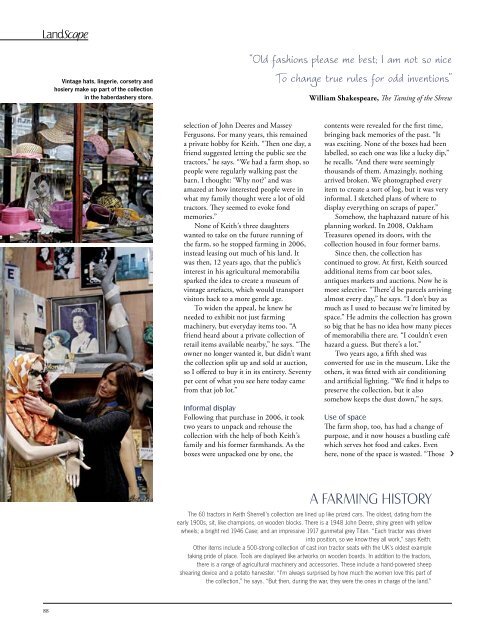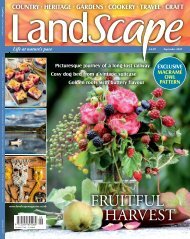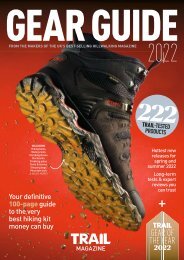You also want an ePaper? Increase the reach of your titles
YUMPU automatically turns print PDFs into web optimized ePapers that Google loves.
Vintage hats, lingerie, corsetry and<br />
hosiery make up part of the collection<br />
in the haberdashery store.<br />
“Old fashions please me best; I am not so nice<br />
To change true rules for odd inventions”<br />
William Shakespeare, The Taming of the Shrew<br />
selection of John Deeres and Massey<br />
Fergusons. For many years, this remained<br />
a private hobby for Keith. “Then one day, a<br />
friend suggested letting the public see the<br />
tractors,” he says. “We had a farm shop, so<br />
people were regularly walking past the<br />
barn. I thought: ‘Why not?’ and was<br />
amazed at how interested people were in<br />
what my family thought were a lot of old<br />
tractors. They seemed to evoke fond<br />
memories.”<br />
None of Keith’s three daughters<br />
wanted to take on the future running of<br />
the farm, so he stopped farming in 2006,<br />
instead leasing out much of his land. It<br />
was then, 12 years ago, that the public’s<br />
interest in his agricultural memorabilia<br />
sparked the idea to create a museum of<br />
vintage artefacts, which would transport<br />
visitors back to a more gentle age.<br />
To widen the appeal, he knew he<br />
needed to exhibit not just farming<br />
machinery, but everyday items too. “A<br />
friend heard about a private collection of<br />
retail items available nearby,” he says. “The<br />
owner no longer wanted it, but didn’t want<br />
the collection split up and sold at auction,<br />
so I offered to buy it in its entirety. Seventy<br />
per cent of what you see here today came<br />
from that job lot.”<br />
Informal display<br />
Following that purchase in 2006, it took<br />
two years to unpack and rehouse the<br />
collection with the help of both Keith’s<br />
family and his former farmhands. As the<br />
boxes were unpacked one by one, the<br />
contents were revealed for the first time,<br />
bringing back memories of the past. “It<br />
was exciting. None of the boxes had been<br />
labelled, so each one was like a lucky dip,”<br />
he recalls. “And there were seemingly<br />
thousands of them. Amazingly, nothing<br />
arrived broken. We photographed every<br />
item to create a sort of log, but it was very<br />
informal. I sketched plans of where to<br />
display everything on scraps of paper.”<br />
Somehow, the haphazard nature of his<br />
planning worked. In 2008, Oakham<br />
Treasures opened its doors, with the<br />
collection housed in four former barns.<br />
Since then, the collection has<br />
continued to grow. At first, Keith sourced<br />
additional items from car boot sales,<br />
antiques markets and auctions. Now he is<br />
more selective. “There’d be parcels arriving<br />
almost every day,” he says. “I don’t buy as<br />
much as I used to because we’re limited by<br />
space.” He admits the collection has grown<br />
so big that he has no idea how many pieces<br />
of memorabilia there are. “I couldn’t even<br />
hazard a guess. But there’s a lot.”<br />
Two years ago, a fifth shed was<br />
converted for use in the museum. Like the<br />
others, it was fitted with air conditioning<br />
and artificial lighting. “We find it helps to<br />
preserve the collection, but it also<br />
somehow keeps the dust down,” he says.<br />
Use of space<br />
The farm shop, too, has had a change of<br />
purpose, and it now houses a bustling café<br />
which serves hot food and cakes. Even<br />
here, none of the space is wasted. “Those ›<br />
A FARMING HISTORY<br />
The 60 tractors in Keith Sherrell’s collection are lined up like prized cars. The oldest, dating from the<br />
early 1900s, sit, like champions, on wooden blocks. There is a 1948 John Deere, shiny green with yellow<br />
wheels; a bright red 1946 Case; and an impressive 1917 gunmetal grey Titan. “Each tractor was driven<br />
into position, so we know they all work,” says Keith.<br />
Other items include a 500-strong collection of cast iron tractor seats with the UK’s oldest example<br />
taking pride of place. Tools are displayed like artworks on wooden boards. In addition to the tractors,<br />
there is a range of agricultural machinery and accessories. These include a hand-powered sheep<br />
shearing device and a potato harvester. “I’m always surprised by how much the women love this part of<br />
the collection,” he says. “But then, during the war, they were the ones in charge of the land.”<br />
88

















